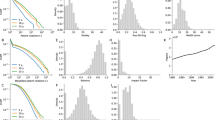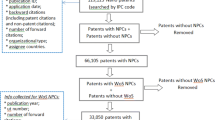Abstract
How science contributes to technological innovation can benefit from a deep understanding of intrinsic characteristics of the science base that underlie technologies, especially characteristics with significant implications for the scientific base itself. This paper investigates the correlation between interdisciplinarity of scientific research (variety, balance, disparity, and Rao-Stirling) and their technological impact. Using all Web of Science research articles published in 2002 and USPTO patents, we find that the likelihood of a paper being cited by patents increases with variety and Rao-Stirling, and decreases with balance and disparity. Regarding specific technological impact, the significance of interdisciplinarity is more prominent in the long term and exhibits variations among different disciplines. Specifically, the intensity of technical impact decreases at a decreasing rate with variety over time, increases at a decreasing rate with Rao-Stirling over time, and decreases with disparity in the long term. Balance is insignificant but it presents a positive correlation in medicine and a negative correlation in natural science in the long term. The scope of technological impact focuses on the number of claims and IPCs, increase with variety and disparity in the long term, and increase with balance in the short term, but such positive correlation only in natural science in the long term. Furthermore, scientific impact and technological impact are closely related in our study, but in order to have technological impacts, interdisciplinary papers need first to reach a certain threshold in scientific impact. Our findings suggest that what is considered excellent within interdisciplinary research can potentially lead to remarkable advancements in technological innovation.




Similar content being viewed by others
References
Ahlgren, P., Jarneving, B., & Rousseau, R. (2003). Requirements for a cocitation similarity measure, with special reference to Pearson’s correlation coefficient. Journal of the American Society for Information Science and Technology, 54(6), 550–560.
Ahmadpoor, M., & Jones, B. F. (2017). The dual frontier: Patented inventions and prior scientific advance. Science, 357(6351), 583–587.
Arora, A., Belenzon, S., & Suh, J. (2022). Science and the market for technology. Management Science. https://doi.org/10.1287/mnsc.2021.4268
Branstetter, L. (2005). Exploring the link between academic science and industrial innovation. Annales D’economie Et De Statistique, 79, 119–142.
Bromham, L., Dinnage, R., & Hua, X. (2016). Interdisciplinary research has consistently lower funding success. Nature, 534(7609), 684–687.
Bush, V. (1945). The endless frontier. National Science Foundation–EUA.
Cassiman, B., Veugelers, R., & Zuniga, P. (2008). In search of performance effects of (in) direct industry science links. Industrial and Corporate Change, 17(4), 611–646.
Cech, T. R., & Rubin, G. M. (2004). Nurturing interdisciplinary research. Nature Structural & Molecular Biology, 11(12), 1166–1169.
Chen, S., Qiu, J., Arsenault, C., & Larivière, V. (2021). Exploring the interdisciplinarity patterns of highly cited papers. Journal of Informetrics, 15(1), 101124.
Chen, S., Song, Y., Shu, F., & Larivière, V. (2022). Interdisciplinarity and impact: The effects of the citation time window. Scientometrics, 127(5), 2621–2642.
Coccia, M. (2022). Probability of discoveries between research fields to explain scientific and technological change. Technology in Society, 68, 101874.
D’este, P., Llopis, O., Rentocchini, F., & Yegros, A. (2019). The relationship between interdisciplinarity and distinct modes of university-industry interaction. Research Policy, 48(9), 103799.
Fleming, L., & Sorenson, O. (2004). Science as a map in technological search. Strategic Management Journal, 25(8–9), 909–928.
Fontana, M., Iori, M., Sciabolazza, V. L., & Souza, D. (2022). The interdisciplinarity dilemma: Public versus private interests. Research Policy, 51(7), 104553.
Gittelman, M., & Kogut, B. (2003). Does good science lead to valuable knowledge? Biotechnology firms and the evolutionary logic of citation patterns. Management Science, 49(4), 366–382.
Hicks, D., Breitzman, A., Sr., Hamilton, K., & Narin, F. (2000). Research excellence and patented innovation. Science and Public Policy, 27(5), 310–320.
Ke, Q. (2018). Comparing scientific and technological impact of biomedical research. Journal of Informetrics, 12(3), 706–717.
Ke, Q. (2020a). Interdisciplinary research and technological impact. arXiv preprint arXiv:2006.15383.
Ke, Q. (2020b). Technological impact of biomedical research: The role of basicness and novelty. Research Policy, 49(7), 104071.
Ke, Q. (2023). Interdisciplinary research and technological impact: Evidence from biomedicine. Scientometrics, 128(4), 2035–2077.
Kevles, D. J. (1977). The National Science Foundation and the debate over postwar research policy, 1942–1945: A political interpretation of science-the endless frontier. Isis, 68(1), 5–26.
Kwon, S. (2022). Interdisciplinary knowledge integration as a unique knowledge source for technology development and the role of funding allocation. Technological Forecasting and Social Change, 181, 121767.
Kwon, S., Youtie, J., & Porter, A. L. (2021). Interdisciplinary knowledge combinations and emerging technological topics: Implications for reducing uncertainties in research evaluation. Research Evaluation, 30(1), 127–140.
Larivière, V., & Gingras, Y. (2010). On the relationship between interdisciplinarity and scientific impact. Journal of the American Society for Information Science and Technology, 61(1), 126–131.
Larivière, V., Haustein, S., & Börner, K. (2015). Long-distance interdisciplinarity leads to higher scientific impact. PLoS ONE, 10(3), e0122565.
Leten, B., Kelchtermans, S., & Belderbos, R. (2022). How does basic research improve innovation performance in the world’s major pharmaceutical firms? Industry and Innovation, 29(3), 396–424.
Leydesdorff, L., & Rafols, I. (2011). Indicators of the interdisciplinarity of journals: Diversity, centrality, and citations. Journal of Informetrics, 5(1), 87–100.
Leydesdorff, L., Wagner, C. S., & Bornmann, L. (2019). Diversity measurement: Steps towards the measurement of interdisciplinarity? Journal of Informetrics, 13(3), 904–905.
Malva, A. D., Kelchtermans, S., Leten, B., & Veugelers, R. (2015). Basic science as a prescription for breakthrough inventions in the pharmaceutical industry. The Journal of Technology Transfer, 40, 670–695.
Mansfield, E. (1991). Academic research and industrial innovation. Research Policy, 20(1), 1–12.
Marx, M., & Fuegi, A. (2020). Reliance on science: Worldwide front-page patent citations to scientific articles. Strategic Management Journal, 41(9), 1572–1594.
McMillan, G. S., Narin, F., & Deeds, D. L. (2000). An analysis of the critical role of public science in innovation: The case of biotechnology. Research Policy, 29(1), 1–8.
Meyer, M. (2000). Does science push technology? Patents citing scientific literature. Research Policy, 29(3), 409–434.
Meyer, M. (2001). Patent citation analysis in a novel field of technology: An exploration of nano-science and nano-technology. Scientometrics, 51(1), 163–183.
Min, C., & Ke, Q. (2021). Temporal search in the scientific space predicts breakthrough inventions. arXiv preprint arXiv:2107.09176.
Narin, F., Hamilton, K. S., & Olivastro, D. (1997). The increasing linkage between US technology and public science. Research Policy, 26(3), 317–330.
National Academy of Sciences. (2005). Facilitating interdisciplinary research. Washington, DC: National Academies Press.
Nelson, R. (1962). The link between science and invention: The case of the transistor. The rate and direction of inventive activity: Economic and social factors (pp. 549–584). Princeton University Press.
Nijssen, D., Rousseau, R., & Van Hecke, P. (1998). The Lorenz curve: A graphical representation of evenness. Coenoses, 13, 33–38.
Persoon, P. G., Bekkers, R. N., & Alkemade, F. (2020). The science base of renewables. Technological Forecasting and Social Change, 158, 120121.
Pezzoni, M., Veugelers, R., & Visentin, F. (2022). How fast is this novel technology going to be a hit? Antecedents Predicting Follow-on Inventions. Research Policy, 51(3), 104454.
Poege, F., Harhoff, D., Gaessler, F., & Baruffaldi, S. (2019). Science quality and the value of inventions. Science Advances, 5(12), eaay7323.
Popp, D. (2017). From science to technology: The value of knowledge from different energy research institutions. Research Policy, 46(9), 1580–1594.
Rylance, R. (2015). Grant giving: Global funders to focus on interdisciplinarity. Nature, 525(7569), 313–315.
Shin, S. R., Lee, J., Jung, Y. R., & Hwang, J. (2022). The diffusion of scientific discoveries in government laboratories: The role of patents filed by government scientists. Research Policy, 51(5), 104496.
Stirling, A. (2007). A general framework for analysing diversity in science, technology and society. Journal of the Royal Society Interface, 4(15), 707–719.
Uzzi, B., Mukherjee, S., Stringer, M., & Jones, B. (2013). Atypical combinations and scientific impact. Science, 342(6157), 468–472.
Van Raan, A. F. (2017). Sleeping beauties cited in patents: Is there also a dormitory of inventions? Scientometrics, 110(3), 1123–1156.
van Raan, A. F., & Winnink, J. J. (2018). Do younger sleeping beauties prefer a technological prince? Scientometrics, 114(2), 701–717.
Veugelers, R., & Wang, J. (2019). Scientific novelty and technological impact. Research Policy, 48(6), 1362–1372.
Wang, J., & Verberne, S. (2021). Two tales of science technology linkage: Patent in-text versus front-page references. arXiv preprint arXiv:2103.08931.
Wang, J., Thijs, B., & Glänzel, W. (2015). Interdisciplinarity and impact: Distinct effects of variety, balance, and disparity. PLoS ONE, 10(5), e0127298.
Wang, J., Veugelers, R., & Stephan, P. (2017). Bias against novelty in science: A cautionary tale for users of bibliometric indicators. Research Policy, 46(8), 1416–1436.
Wang, L., & Li, Z. (2021). Knowledge flows from public science to industrial technologies. The Journal of Technology Transfer, 46(4), 1232–1255.
Yegros-Yegros, A., Rafols, I., & D’este, P. (2015). Does interdisciplinary research lead to higher citation impact? The different effect of proximal and distal interdisciplinarity. PLoS ONE, 10(8), e0135095.
Zhang, L., Sun, B., Jiang, L., & Huang, Y. (2021). On the relationship between interdisciplinarity and impact: Distinct effects on academic and broader impact. Research Evaluation, 30(3), 256–268.
Acknowledgements
The authors wish to thank Kyle Siler at Université de Montréal for helpful feedback, and Observatoire des sciences et des technologies for providing the data. This article has been funded by the Scholarship Fund from the China Scholarship Council (CSC).
Author information
Authors and Affiliations
Corresponding author
Ethics declarations
Conflict of interest
Vincent Larivière is a member of the of Distinguished Reviewers Board of Scientometrics.
Additional information
Publisher's Note
Springer Nature remains neutral with regard to jurisdictional claims in published maps and institutional affiliations.
Rights and permissions
Springer Nature or its licensor (e.g. a society or other partner) holds exclusive rights to this article under a publishing agreement with the author(s) or other rightsholder(s); author self-archiving of the accepted manuscript version of this article is solely governed by the terms of such publishing agreement and applicable law.
About this article
Cite this article
Li, B., Chen, S. & Larivière, V. Interdisciplinarity affects the technological impact of scientific research. Scientometrics 128, 6527–6559 (2023). https://doi.org/10.1007/s11192-023-04846-8
Received:
Accepted:
Published:
Issue Date:
DOI: https://doi.org/10.1007/s11192-023-04846-8




